Clinical death is the medical term for cessation of blood circulation and breathing, the two criteria necessary to sustain the lives of human beings and of many other organisms. It occurs when the heart stops beating in a regular rhythm, a condition called cardiac arrest. The term is also sometimes used in resuscitation research.
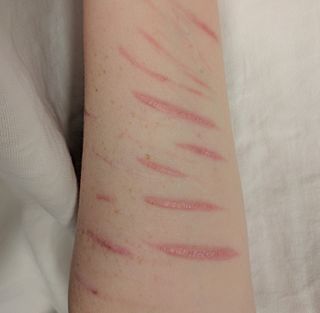
Self-harm is intentional behavior that is considered harmful to oneself. This is most commonly regarded as direct injury of one's own skin tissues usually without a suicidal intention. Other terms such as cutting, self-injury, and self-mutilation have been used for any self-harming behavior regardless of suicidal intent. Common forms of self-harm include damaging the skin with a sharp object or by scratching, hitting, or burning. The exact bounds of self-harm are imprecise, but generally exclude tissue damage that occurs as an unintended side-effect of eating disorders or substance abuse, as well as societally acceptable body modification such as tattoos and piercings.
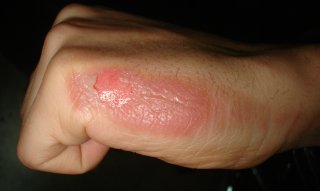
A burn is an injury to skin, or other tissues, caused by heat, cold, electricity, chemicals, friction, or ultraviolet radiation. Most burns are due to heat from hot liquids, solids, or fire. Burns occur mainly in the home or the workplace. In the home, risks are associated with domestic kitchens, including stoves, flames, and hot liquids. In the workplace, risks are associated with fire and chemical and electric burns. Alcoholism and smoking are other risk factors. Burns can also occur as a result of self-harm or violence between people (assault).

Psychological pain, mental pain, or emotional pain is an unpleasant feeling of a psychological, non-physical origin. A pioneer in the field of suicidology, Edwin S. Shneidman, described it as "how much you hurt as a human being. It is mental suffering; mental torment." There is no shortage in the many ways psychological pain is referred to, and using a different word usually reflects an emphasis on a particular aspect of mind life. Technical terms include algopsychalia and psychalgia, but it may also be called mental pain, emotional pain, psychic pain, social pain, spiritual or soul pain, or suffering. While these clearly are not equivalent terms, one systematic comparison of theories and models of psychological pain, psychic pain, emotional pain, and suffering concluded that each describe the same profoundly unpleasant feeling. Psychological pain is widely believed to be an inescapable aspect of human existence.

An injury is any physiological damage to living tissue caused by immediate physical stress. Injuries to humans can occur intentionally or unintentionally and may be caused by blunt trauma, penetrating trauma, burning, toxic exposure, asphyxiation, or overexertion. Injuries can occur in any part of the body, and different symptoms are associated with different injuries.
Self-hatred is personal self-loathing or low self-esteem which may lead to self-harm.

Major trauma is any injury that has the potential to cause prolonged disability or death. There are many causes of major trauma, blunt and penetrating, including falls, motor vehicle collisions, stabbing wounds, and gunshot wounds. Depending on the severity of injury, quickness of management, and transportation to an appropriate medical facility may be necessary to prevent loss of life or limb. The initial assessment is critical, and involves a physical evaluation and also may include the use of imaging tools to determine the types of injuries accurately and to formulate a course of treatment.
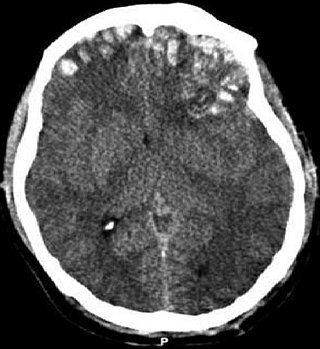
A traumatic brain injury (TBI), also known as an intracranial injury, is an injury to the brain caused by an external force. TBI can be classified based on severity ranging from mild traumatic brain injury (mTBI/concussion) to severe traumatic brain injury. TBI can also be characterized based on mechanism or other features. Head injury is a broader category that may involve damage to other structures such as the scalp and skull. TBI can result in physical, cognitive, social, emotional and behavioral symptoms, and outcomes can range from complete recovery to permanent disability or death.

Blunt trauma, also known as blunt force trauma or non-penetrating trauma, describes a physical trauma due to a forceful impact without penetration of the body's surface. Blunt trauma stands in contrast with penetrating trauma, which occurs when an object pierces the skin, enters body tissue, and creates an open wound. Blunt trauma occurs due to direct physical trauma or impactful force to a body part. Such incidents often occur with road traffic collisions, assaults, sports-related injuries, and are notably common among the elderly who experience falls.
Deep hypothermic circulatory arrest (DHCA) is a surgical technique in which the temperature of the body falls significantly and blood circulation is stopped for up to one hour. It is used when blood circulation to the brain must be stopped because of delicate surgery within the brain, or because of surgery on large blood vessels that lead to or from the brain. DHCA is used to provide a better visual field during surgery due to the cessation of blood flow. DHCA is a form of carefully managed clinical death in which heartbeat and all brain activity cease.
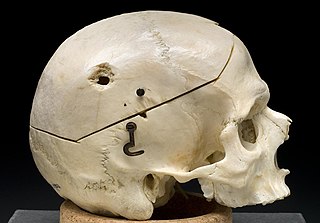
A gunshot wound (GSW) is a penetrating injury caused by a projectile from a gun. Damages may include bleeding, bone fractures, organ damage, wound infection, loss of the ability to move part of the body, and in severe cases, death. Damage depends on the part of the body hit, the path the bullet follows through the body, and the type and speed of the bullet. Long-term complications can include bowel obstruction, failure to thrive, neurogenic bladder and paralysis, recurrent cardiorespiratory distress and pneumothorax, hypoxic brain injury leading to early dementia, amputations, chronic pain and pain with light touch (hyperalgesia), deep venous thrombosis with pulmonary embolus, limb swelling and debility, and lead poisoning.

Penetrating trauma is an open wound injury that occurs when an object pierces the skin and enters a tissue of the body, creating a deep but relatively narrow entry wound. In contrast, a blunt or non-penetrating trauma may have some deep damage, but the overlying skin is not necessarily broken and the wound is still closed to the outside environment. The penetrating object may remain in the tissues, come back out the path it entered, or pass through the full thickness of the tissues and exit from another area.
Multiple-gunshot suicide occurs when an individual commits suicide by inflicting multiple gunshots on itself before becoming incapacitated. It excludes suicides where the firearms are operated by other people, such as suicide by cop.
Self-embedding is the insertion of foreign objects either into soft tissues under the skin or into muscle. Self-embedding is typically considered deliberate self-harm, also known as nonsuicidal self-injury, which is defined as "deliberate, direct destruction of tissues without suicidal intent."
A suicide attempt is an act in which an individual tries to kill themselves but survives. Mental health professionals discourage describing suicide attempts as "failed" or "unsuccessful", as doing so may imply that a suicide resulting in death is a successful or desirable outcome.
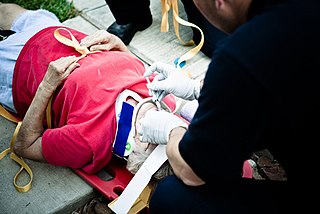
Geriatric trauma refers to a traumatic injury that occurs to an elderly person. People around the world are living longer than ever. In developed and underdeveloped countries, the pace of population aging is increasing. By 2050, the world's population aged 60 years and older is expected to total 2 billion, up from 900 million in 2015. While this trend presents opportunities for productivity and additional experiences, it also comes with its own set of challenges for health systems. More so than ever, elderly populations are presenting to the Emergency Department following traumatic injury. In addition, given advances in the management of chronic illnesses, more elderly adults are living active lifestyles and are at risk of traumatic injury. In the United States, this population accounts for 14% of all traumatic injuries, of which a majority are just mainly from falls.

A stab wound is a specific form of penetrating trauma to the skin that results from a knife or a similar pointed object. While stab wounds are typically known to be caused by knives, they can also occur from a variety of implements, including broken bottles and ice picks. Most stabbings occur because of intentional violence or through self-infliction. The treatment is dependent on many different variables such as the anatomical location and the severity of the injury. Even though stab wounds are inflicted at a much greater rate than gunshot wounds, they account for less than 10% of all penetrating trauma deaths.
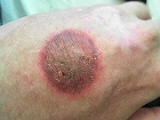
An aerosol frostbite of the skin is an injury to the body caused by the pressurized gas within an aerosol spray cooling quickly, with the sudden drop in temperature sufficient to cause frostbite to the applied area. Medical studies have noted an increase of this practice, known as "frosting", in pediatric and teenage patients.
Historically, suicide terminology has been rife with issues of nomenclature, connotation, and outcomes, and terminology describing suicide has often been defined differently depending on the purpose of the definition. A lack of agreed-upon nomenclature and operational definitions has complicated understanding. In 2007, attempts were made to reach some consensus. There is also opposition to the phrase "to commit suicide" as implying negative moral judgment and association with criminal or sinful activity.
Suicide and trauma is the increased risk of suicide that is caused by psychological trauma.











